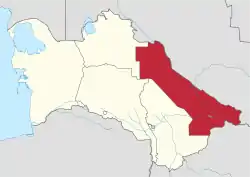Lebap Region
Lebap Region (Turkmen: Lebap welaýaty/Лебап велаяты from the Persian لب آب Labe âb) is one of the regions of Turkmenistan. It is in the northeast of the country, bordering Afghanistan, Uzbekistan along the Amu Darya. Its capital is Türkmenabat (formerly named Çärjew). It has an area of 93,730 square kilometers, and a population of 1,334,500 people (2005 est.).[1]
Lebap | |
|---|---|
 Lebap welaýatynyň Ruhyýet köşgi | |
 Lebap region in Turkmenistan | |
| Country | |
| Capital | Türkmenabat |
| Area | |
| • Total | 93,730 km2 (36,190 sq mi) |
| Population (2005) | |
| • Total | 1,334,500 |
| • Density | 14/km2 (37/sq mi) |
The name Lebap is Turkmenized form of the Persian Lab-e āb (Persian: لب آب) which means "riverside" and has long been used to designate the middle reaches of the Amu Darya river.[2]
It contains the Repetek Nature Reserve and the Köýtendag Nature Reserve, which has Turkmenistan's highest mountain, Aýrybaba (3137 meters).
The region is located along the Amuderya River. The Kyzylkum Desert is located east side of river and Karakum Desert is located west side of river. The region's sunny weather and abundance of water resources help produce one of the highest quality cotton and wheat in the world.
History
The region of present-day Lebap once occupied a spot along the Silk Road, and the 12th century-era caravansary of Dayahatyn is located within Lebap.[3]
On April 27, 2020, the province was hit by a severe windstorm.[4] RadioFreeEurope/RadioLiberty alleged that the storm disrupted much of the province's electrical grid, public water supplies, natural gas connections, cell service, and internet connection.[4] A local human rights website, Turkmen.news, reported that many people were admitted to the provincial hospital in Türkmenabat after suffering injuries.[4] They also alleged that there was sporadic looting in the storm's aftermath, and that food prices in the region rose as a result of the storm.[4] Local Turkmen media reported 10 deaths resulting from the storm, while Turkmen.news suggested that the true death toll was likely in the dozens, and dozens remained unaccounted for in the storm's aftermath.[4] The rights group Human Rights Watch condemned what it perceived as "censorship" by local officials following the storm, noting that one group alleged that local police were watching out for people filming the storm's damage, and another group reported that dozens of people were detained for allegedly sending videos "abroad".[5]
In December 2020, RadioFreeEurope/RadioLiberty reported that regional officials threatened to cut off the region's population from subsidized food if they were not up to date on their utility bills.[6] The agency reported that many in the province received seasonal income from farming, and often did not earn money in the winter, and such matters were complicated by a decrease in remittances to the region as a result of the economic fallout from Covid-19.[6]
Administrative divisions
Districts
As of November 27, 2017, Lebap Province (Turkmen: Lebap welaýaty) is subdivided into 10 districts (etrap, plural etraplar):[7][8][9]
- Çarjew (formerly Serdarabat)
- Darganata (formerly Birata)
- Dänew (formerly Galkynyş)
- Döwletli
- Farap
- Halaç
- Hojambaz
- Kerki (formerly Atamyrat)
- Köýtendag
- Saýat
On that date, four districts (Beýik Türkmenbaşy, Garaşsyzlyk, Garabekwül, and Sakar) were abolished and their territories absorbed by other districts.[9]
Incorporated settlements
As of January 1, 2017, the province included 15 cities (Turkmen: şäherler, Russian: города), 23 towns (Turkmen: şäherçeler, Russian: посёлки), 106 rural or village councils (Turkmen: geňeşlikler, Russian: сельские советы), and 430 villages (Turkmen: obalar, Russian: села, or Russian: сельские населенные пункты).[7][8]
Economy
Lebap is rich in various natural resources, most notably, natural gas. The region is home to the Malai Gas Field, and the Bagtiyarlik Gas Field, which both serve as major suppliers of natural gas to China.[10][11]
References
- Statistical Yearbook of Turkmenistan 2000-2004, National Institute of State Statistics and Information of Turkmenistan, Ashgabat, 2005.
- UNESCO., Ahmad Hasan Dani, and V. M. Masson. 1992. History of civilizations of Central Asia. Vol. V. Paris: Unesco. p.128
- "Ambassador Mustard Travels to Lebap Province". U.S. Embassy in Turkmenistan. United States Department of State. 2015-06-04. Archived from the original on 2021-01-01. Retrieved 2021-01-01.
- "Turkmen Province 'In Chaos' After Deadly Windstorms". RadioFreeEurope/RadioLiberty. U.S. Agency for Global Media. Archived from the original on 2021-01-01. Retrieved 2021-01-01.
- "Turkmenistan Government's Deafening Silence After Hurricane". Human Rights Watch. 2020-05-04. Archived from the original on 2020-09-24. Retrieved 2021-01-01.
- Najibullah, Farangis (2020-12-25). "Grim Choice: Turkmen Warned Of Food Cutoffs Over Unpaid Utility Bills". RadioFreeEurope/RadioLiberty. Archived from the original on 2021-01-01. Retrieved 2021-01-01.
- Türkmenistanyň Mejlisi (2010–2018). "Türkmenistanyň dolandyryş-çäk birlikleriniň Sanawy". Türkmenistanyş Mejlisiniň Karary. Ashgabat. This document is reproduced online at https://wiki.openstreetmap.org/wiki/Districts_in_Turkmenistan.
- Административно-территориальное деление Туркменистана по регионам по состоянию на 1 января 2017 года (in Russian). State Committee of Turkmenistan on Statistics. Archived from the original on 2018-07-08. Retrieved 2018-07-08.
- Внесены изменения в административно-территориальное деление Лебапского велаята. turkmenistan.gov.tm (in Russian). 2017-11-27. Archived from the original on 2018-07-08. Retrieved 2021-01-01.
- "Turkmenistan to up gas supply to China". AzerNews. 2016-04-25. Archived from the original on 2021-01-01. Retrieved 2021-01-01.
- "Turkmenistan supplied 125BCM of gas to China". Natural Gas Europe. Natural Gas World. 2015-09-28. Archived from the original on 2016-08-11. Retrieved 2021-01-01.